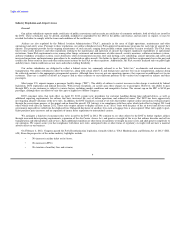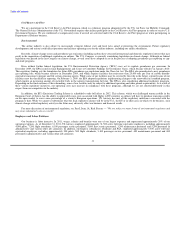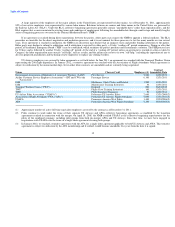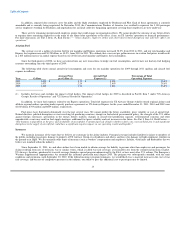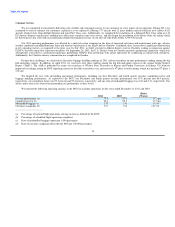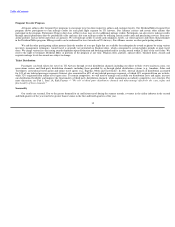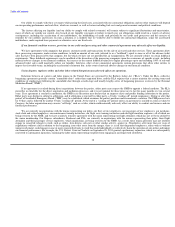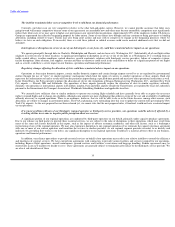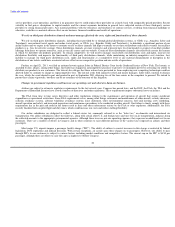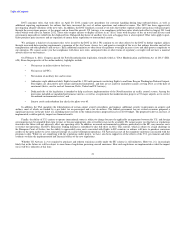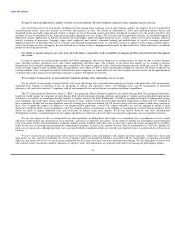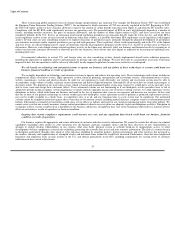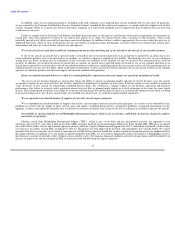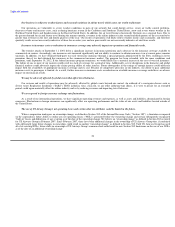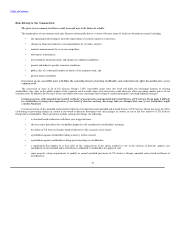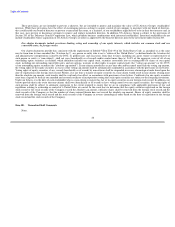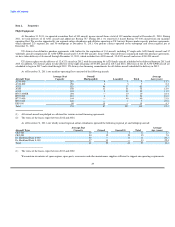US Airways 2011 Annual Report Download - page 22
Download and view the complete annual report
Please find page 22 of the 2011 US Airways annual report below. You can navigate through the pages in the report by either clicking on the pages listed below, or by using the keyword search tool below to find specific information within the annual report.
Table of Contents
The inability to maintain labor costs at competitive levels would harm our financial performance.
Currently, our labor costs are very competitive relative to the other hub-and-spoke carriers. However, we cannot provide assurance that labor costs
going forward will remain competitive because some of our agreements are amendable now and others may become amendable, competitors may significantly
reduce their labor costs or we may agree to higher-cost provisions in our current labor negotiations. Approximately 85% of the employees within US Airways
Group are represented for collective bargaining purposes by labor unions. Some of our unions have brought and may continue to bring grievances to binding
arbitration, including related to wages. Unions may also bring court actions and may seek to compel us to engage in the bargaining processes where we
believe we have no such obligation. If successful, there is a risk these judicial or arbitral avenues could create material additional costs that we did not
anticipate.
Interruptions or disruptions in service at one of our hub airports or our focus city could have a material adverse impact on our operations.
We operate principally through hubs in Charlotte, Philadelphia and Phoenix, and our focus city, Washington, D.C. Substantially all of our flights either
originate in or fly into one of these locations. A significant interruption or disruption in service at one of our hubs or at Washington, D.C. resulting from air
traffic control delays, weather conditions, natural disasters, growth constraints, relations with third-party service providers, failure of computer systems,
facility disruptions, labor relations, fuel supplies, terrorist activities or otherwise could result in the cancellation or delay of a significant portion of our flights
and, as a result, could have a severe impact on our business, operations and financial performance.
Regulatory changes affecting the allocation of slots could have a material adverse impact on our operations.
Operations at four major domestic airports, certain smaller domestic airports and certain foreign airports served by us are regulated by governmental
entities through the use of "slots" or similar regulatory mechanisms which limit the rights of carriers to conduct operations at those airports. Each slot
represents the authorization to land at or take off from the particular airport during a specified time period and may have other operational restrictions as well.
In the United States, the FAA currently regulates the allocation of slot or slot exemptions at Reagan National serving Washington, D.C., and three New York
City airports — Newark, JFK and LaGuardia. Our operations at these airports generally require the allocation of slots or similar regulatory authority.
Similarly, our operations at international airports in Frankfurt, London, Paris and other airports outside the United States are regulated by local slot authorities
pursuant to the International Air Transport Association's Worldwide Scheduling Guidelines and applicable local law.
We currently have sufficient slots or similar authority to operate our existing flight schedule and have generally been able to acquire the necessary
rights to expand flights and to change our schedules, although some airports are more challenging than others in terms of the cost and availability of additional
authority necessary to expand operations. There is no assurance, however, that we will be able to do so in the future because, among other reasons, such
allocations are subject to changes in government policy. The FAA is planning a new rulemaking later this year to update the current rules governing the New
York City airports. As the new proposal has not been released yet, we cannot state that the new proposed rules, if finalized, would not have a material impact
on our operations.
If we incur problems with any of our third-party regional operators or third-party service providers, our operations could be adversely affected by a
resulting decline in revenue or negative public perception about our services.
A significant portion of our regional operations are conducted by third-party operators on our behalf, primarily under capacity purchase agreements.
Due to our reliance on third parties to provide these essential services, we are subject to the risks of disruptions to their operations, which may result from
many of the same risk factors disclosed in this report, such as the impact of adverse economic conditions, and other risk factors, such as a bankruptcy
restructuring of any of the regional operators. We may also experience disruption to our regional operations if we terminate the capacity purchase agreement
with one or more of our current operators and transition the services to another provider. As our regional segment provides revenues to us directly and
indirectly (by providing flow traffic to our hubs), any significant disruption to our regional operations would have a material adverse effect on our business,
operations and financial performance.
In addition, our reliance upon others to provide essential services on behalf of our operations may result in our relative inability to control the efficiency
and timeliness of contract services. We have entered into agreements with contractors to provide various facilities and services required for our operations,
including Express flight operations, aircraft maintenance, ground services and facilities, reservations and baggage handling. Similar agreements may be
entered into in any new markets we decide to serve. These agreements are generally subject to termination after notice by the third-party service provider. We
are also at risk should one of these
19


